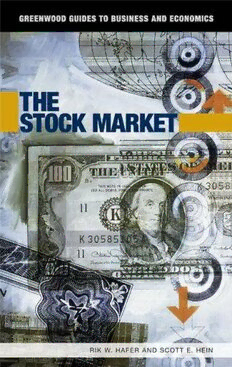
One
Introduction
Stocks and the markets in which they are traded are important parts of our
personal finances and national economies. Today more people than ever own
stocks directly, or indirectly through mutual funds, 401k programs, or pen-
sion plans. In the bigger picture, stock markets offer individuals and in-
stitutions a means to build wealth or reduce risk of financial loss. The
increasingly complex web of financial transactions that characterize today’s
economy often puts stock markets at the center of economic booms and busts.
More and more, everyone looks to ‘‘the market’’ for a signal on where the
economy is headed.
Stocks represent a retirement nest egg for households and a source of
financing for businesses. Without the availability of stocks and the develop-
ment of financial markets, there would not have been the substantial growth
in new businesses created or the growth in our economy. It is, therefore, im-
portant for everyone to have a good understanding of stocks and stock
markets.
What is a stock? This may sound simple, but it is a useful question to get
the discussion rolling. Pick up a finance textbook and it will say that a stock is
a financial asset to its owner. It also will say that a stock is a claim against the
firm that issued it. Both are correct. When a company issues stock, it acquires
funds from those who initially purchase it. Firms sell stock to expand their
operations, using the funds to, say, build a new factory or launch a new product
line. Once the stock is purchased, however, the firm actually gets no addi-
tional funds when the stock is traded over and over. That is, when someone
calls a broker and buys a share of Google, the money spent is simply trans-
ferred to someone who has decided to sell a share of Google. Once stocks are
publicly traded, the issuing firm receives no additional funds.
Even though the firm receives no additional funds from the public trading
of its stock, those outstanding shares are claims against the firm. Owning a
share of Google gives you some claim over their future profits, and some claim
over how the firm is run—shareholders can vote at Google’s annual meeting.
The former aspect of stock ownership is important because if the firm does
well, it is likely that others will want to buy the stock. Since at any one point in
time there are only so many shares of stock outstanding, increased demand for
a stock drives up its price. For instance, if more and more investors think
Google is likely to turn in higher profits, the increased demand for the stock
increases its price. For those who bought Google’s shares early in this process,
as the price increased they became better off: on paper their wealth increased.
It is useful to distinguish at this point the confusion between wealth and
income, especially as it relates to the stock market. Wealth refers to the
difference between the value of assets and liabilities at a point in time. For
example, suppose an individual has 100 shares of XYZ stock, currently priced
at $1. Suppose also that they owe $50 to the local bank on a car loan. If that is
all the financial assets they own and the loan is the only liability, their wealth
is $50, the value of assets (the stock) minus liabilities (the loan). The dis-
tinction is that ‘‘paper wealth’’ is not realized until the stock is sold.
Stocks are traded on a number of exchanges and electronic markets, al-
though trading is heading more and more to electronic trading. An exchange
usually is thought of as a physical location where traders meet face-to-face to
trade stocks. In such an open outcry market, traders announce prices at which
to buy stock, or prices at which they are willing to sell. When the two prices
are matched, a deal is done. One such market is the New York Stock Exchange
(NYSE). Watch any of the financial news networks’ wrap of stock market
activity, and often a reporter is found on the floor of the exchange, surrounded
by people scurrying around. Those people are engaged in trading stocks.
With the advancing technology of trading, the future of markets like the
NYSE is limited. Many stock trades today occur not on the floor of a NYSE-
type exchange but through an electronic connection between brokers and
dealers. This increased sophistication of trading allows information to flow
more rapidly and permits trades to be executed quickly. In the United States,
an example of such a market is the National Association of Securities Dealers
Automated Quotation System (NASDAQ). In the near future, the NYSE also
is moving to an electronic format that will reduce activity on its floor.
This brings up an important though sometimes confused point: Stock
indexes and stock exchanges or markets are two distinctly different things.
The Dow Jones Industrial Average (DJIA) is perhaps the most recognized of
the many stock indexes. The value of the DJIA is derived from changes in the
prices of the thirty stocks that comprise it. The rise or fall of the index on any




